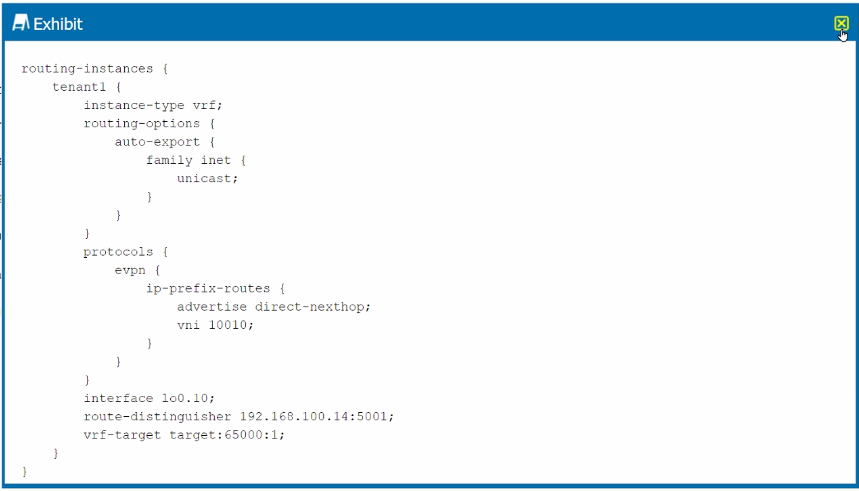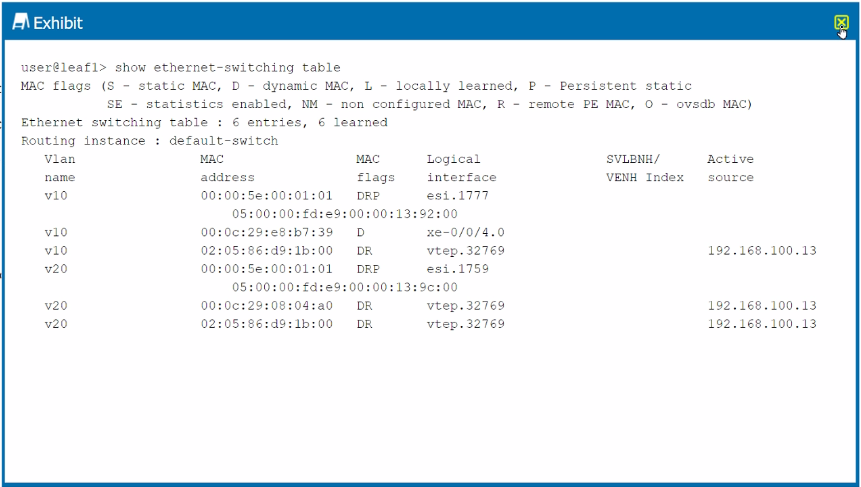Curious about Actual Juniper Data Center Certification (JN0-683) Exam Questions?
Here are sample Juniper Data Center Professional (JN0-683) Exam questions from real exam. You can get more Juniper Data Center Certification (JN0-683) Exam premium practice questions at TestInsights.
Exhibit.

You want to enable the border leaf device to send Type 5 routes of local networks to the border leaf device in another data center. What must be changed to the configuration shown in the exhibit to satisfy this requirement?
Correct : A
In this scenario, you want the border leaf device to advertise Type 5 EVPN routes to another border leaf in a different data center. Type 5 routes in EVPN are used to advertise IP prefixes, which means that for proper route advertisement, you need to configure the correct settings within the evpn hierarchy.
Step-by-Step Analysis:
Understanding EVPN Type 5 Routes:
EVPN Type 5 routes are used to advertise IP prefixes across EVPN instances, which allow different data centers or networks to exchange routing information effectively.
VRF Target Setting:
The vrf-target configuration is crucial because it defines the export and import policies for the VRF within the EVPN instance. For EVPN Type 5 routes to be advertised to other border leaf devices, the vrf-target needs to be correctly configured under the evpn hierarchy, not just within the routing instance.
Command to solve this:
move vrf-target target:65000:1 to evpn
Other Options:
Option B: Adding a VLAN configuration would not address the requirement to advertise Type 5 routes.
Option C: Adding VXLAN encapsulation may be necessary for other scenarios but does not directly address the Type 5 route advertisement.
Option D: Changing the route-distinguisher will differentiate routes but does not impact the advertisement of Type 5 routes to other data centers.
By moving the vrf-target to the evpn hierarchy, you enable the proper route advertisement, ensuring that the Type 5 routes for local networks are shared with other data center border leaf devices. This is aligned with best practices for multi-data center EVPN implementations, which emphasize the correct placement of routing policies within the EVPN configuration.
Start a Discussions
Exhibit.

Referring to the exhibit, why is the active source field blank for the entry that uses the 00:0c:29:e8:b7:39 MAC address?
Correct : A
In this scenario, the active source field is blank for the MAC address 00:0c:29:e8:b7:39, indicating an issue with how this MAC entry is being processed within the EVPN/VXLAN environment.
Step-by-Step Analysis:
Understanding the MAC Entry:
The active source field should normally indicate the source of the route advertisement for a specific MAC address within the EVPN. If it is blank, it suggests that there is a problem with how this entry is being learned or propagated.
Possible Issues:
Option A: If the EVPN route for this MAC address does not have a valid next hop, the entry might exist in the MAC table, but it will not have a valid path for forwarding, leading to a blank active source.
Option B: If the ARP lookup had failed, the entry might not even appear in the MAC table. However, the entry does exist, suggesting that ARP is not the primary issue here.
Option C: If the host were locally connected, the active source should reflect a local interface, but the field is blank, ruling out local connection as the cause.
Option D: Multicast EVPN routes typically do not appear in this manner in the MAC table, and this would not cause the active source to be blank.
Conclusion: The most logical explanation is that the EVPN route for this host exists but does not have a valid next hop, leading to the absence of an active source. This is consistent with how EVPN routing tables work in a VXLAN environment, where the lack of a valid next hop would prevent proper route advertisement and forwarding for the specific MAC address.
Start a Discussions
You are deploying an IP fabric with an oversubscription ratio of 3:1.
In this scenario, which two statements are correct? (Choose two.)
Correct : C, D
Understanding Oversubscription Ratio in IP Fabrics:
The oversubscription ratio in an IP fabric typically refers to the ratio of the available bandwidth at the edge of the network (leaves) to the available bandwidth at the core or spine. A 3:1 oversubscription ratio means that for every 3 units of bandwidth at the leaves, there is 1 unit of bandwidth at the spine.
Impact of Adding or Removing Leaf Devices:
Removing Leaf Devices: When you remove leaf devices, the amount of total edge bandwidth decreases while the bandwidth in the spine remains constant. This causes the oversubscription ratio to increase because there is now less total bandwidth to distribute across the same amount of spine bandwidth.
Adding Leaf Devices: Conversely, when you add leaf devices, the total edge bandwidth increases. Since the spine bandwidth remains the same, the oversubscription ratio would remain the same if the additional leaves consume their share of the available bandwidth proportionally.
Conclusion:
Option C: Correct---Removing leaf devices increases the oversubscription ratio.
Option D: Correct---Adding leaf devices typically maintains the oversubscription ratio assuming uniform bandwidth distribution.
Start a Discussions
You are asked to interconnect two of your company's data centers across the IP backbone. Both data centers have their own unique IP space and do not require any bridging. In this scenario, which two actions would accomplish this task? (Choose two.)
Correct : B, C
Interconnecting Data Centers:
The scenario requires interconnecting two data centers with unique IP spaces across an IP backbone. The key point is that bridging is not required, so Layer 3 routing methods must be used.
EVPN Configuration:
Option B: Establishing EVPN peering between the border leaf nodes in each data center is the most appropriate solution as it allows for exchanging routing information between the two data centers. This ensures that the routes are properly distributed without the need for L2 bridging.
Option C: Configuring Type 5 EVPN routes is necessary for advertising IP prefixes (Layer 3 routes) across the EVPN. Type 5 routes allow for the exchange of IP prefixes between the two data centers, enabling the necessary routing functionality without the need for bridging.
Conclusion:
Option B: Correct---Peering between border leaf nodes sets up the necessary route exchange between data centers.
Option C: Correct---Type 5 EVPN routes are essential for exchanging Layer 3 prefixes between data centers.
Start a Discussions
Which three statements are correct about symmetric IRB routing with EVPN Type 2 routes? (Choose three.)
Correct : A, B, D
Symmetric IRB Routing with EVPN Type 2 Routes:
Symmetric Routing: In symmetric IRB (Integrated Routing and Bridging), routing occurs in both directions at the ingress and egress leaf nodes using the same routing logic. This is contrasted with asymmetric routing, where different routing logic is used depending on the direction of the traffic.
Required Components:
Option A: An L3 IRB interface is necessary for each VLAN that participates in routing, as it handles the Layer 3 processing for the VLAN.
Option B: MAC-VRF is required for symmetric routing to maintain a mapping of MAC addresses to the appropriate VRF, ensuring correct forwarding within the EVPN.
Option D: A transit VNI (Virtual Network Identifier) is required for each VRF to encapsulate the Layer 3 traffic as it traverses the network, allowing the IP traffic to be appropriately forwarded.
Conclusion:
Option A: Correct---Each local VLAN needs an IRB interface for L3 processing.
Option B: Correct---MAC-VRF is necessary for handling MAC address resolution in symmetric routing.
Option D: Correct---Transit VNIs are required for routing VRF-specific traffic across the network.
Options C and E are incorrect because:
C: Symmetric routing can work with various VLAN models, including single or multiple VLANs within an EVPN instance.
E: Symmetric routing is generally more efficient than asymmetric routing as it uses consistent routing logic in both directions.
Start a Discussions
Total 65 questions